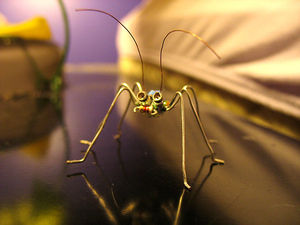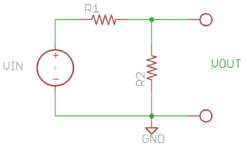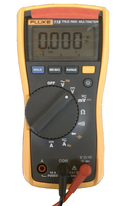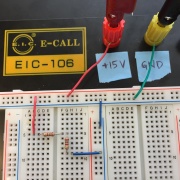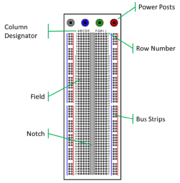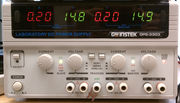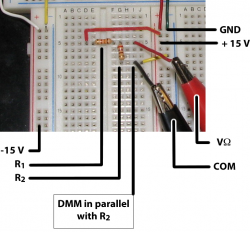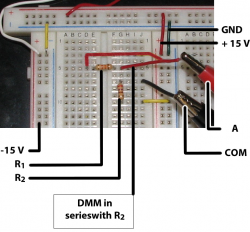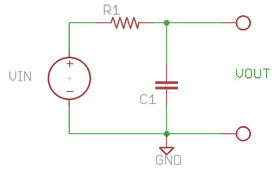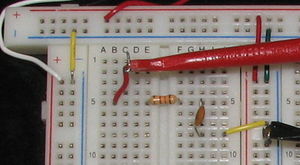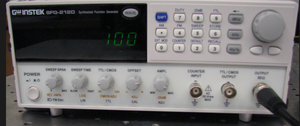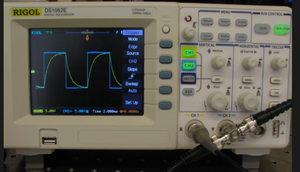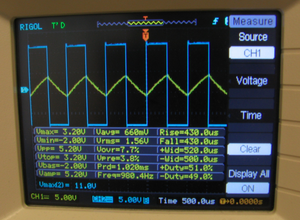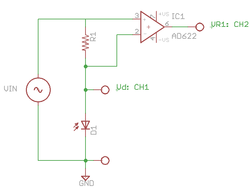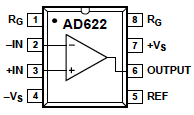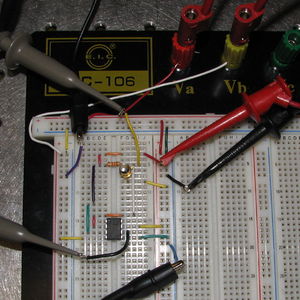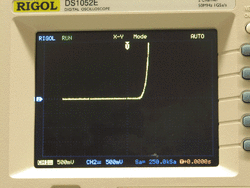Electronics Mini-Lab
Overview
During the next lab exercise on measuring DNA melting curves, you will build and debug several electronic circuits. This mini-lab will introduce you to the electronic components and test equipment you will use. A short answer-book style writeup is required. Items to include in your report are shown below in bold type. Don't forget the basics: report measurements with an appropriate number of significant figures, units, and uncertainty. Label plot axes.
This mini-lab requires an understanding of basic circuits. If you need to review circuit concepts, start with the Electronics Primer page. If you have a lot of experience with electronics, ask one of the instructors about doing a stimulating mini-project instead of the mini-lab assignment.
Voltage divider
In the first part of the mini-lab, you will analyze and build a voltage divider. The divider circuit comprises two resistors and a voltage source, as shown in the schematic diagram. You will select the values for R1 and R2.
Before you build
Choose any two resistor values you like, but there are a few practical constraints. The resistors in the lab range in value from 1 Ω to 10 MΩ. Within that range, manufacturers only produce certain standard values. Check the supply bins or this table to see which values are available.
Power dissipation in resistors increases in proportion to resistance and the square of current, P = I 2R. The maximum power rating of the resistors in the lab is 1/4 Watt. Components operated at too high a power level tend to get very hot and fail. A noxious puff of smoke frequently accompanies failure. Even if a component operated at an excessive power level does not vaporize, it may no longer behave as specified. Ensure that the power dissipated by R1 and R2 does not exceed the maximum rating for Vin values in the range of 0-15 V.
You will use an oscilloscope and a volt meter to measure voltages in the circuit. The oscilloscope has an input impedance of 1 MΩ. Connecting the oscilloscope probe to a node of the circuit is equivalent to placing a 1 MΩ resistor between that node and ground. In circuits that use very large resistors, the current flowing into the oscilloscope can significantly distort measurements.
Before building the divider circuit:
- Record the values you selected for R1 and R2.
- Derive the gain of the circuit Vout / Vin and show your work.
- Plot an I-V curve with I on the vertical axis and Vin on the horizontal axis, over the range 0 V < Vin < 15 V. You may simply draw this by hand.
- What is the maximum power dissipated in each resistor between 0 V < Vin < 15 V?
Another practical issue: tolerance

It's easy enough to write down an exact value for a resistor like 15 kΩ or eπ Ω and analyze a circuit model that contains such a component. But fabricating a 15 kΩ or eπ Ω resistor is another matter. It is not possible to realize physical components with infinite precision. The values you specify on paper are called nominal values. Nominal means: "stated or expressed but not necessarily corresponding exactly to the real value." When you go to build the circuit, the actual value of the resistors you use will be somewhat different than the nominal values you used to analyze the circuit.
To account for the difference between the nominal and actual values of a component, the manufacturer guarantees that the actual value will differ from the nominal value by no more than a certain amount. Resistors are available with larger and smaller tolerances. For the resistors in the lab, the difference is guaranteed to be less than 5% of the nominal value.
Because the actual values of the resistors differ from the nominal values, the power dissipation in R1 and R2 will under some circumstances be greater than what you computed using the nominal values. To be safe, the best thing to do is compute the power dissipated in both resistors under worst-case assumptions.
Measure the resistors with a digital multimeter
Go ahead and get the resistors for your circuit from the bins in the lab.
The value of each resistor is indicated by a set of color-coded bands on the component body. Through negligence or malice of last semester's scholars, components occasionally end up in the wrong bin. Ensure that you have the correct resistors by reading the color bands. Instructions for reading resistor markings are available at this Wikipedia page.
Measure the actual value of both resistors with a digital multimeter (DMM). DMMs are multifunction instruments that usually include functions for measuring voltage, current, and resistance. They connect to component terminals through a pair of test leads. DMMs measure resistance by applying a small voltage across the test leads and measuring the resulting current flow. To get an accurate measurement of a resistor, its leads must be isolated from other circuit elements. If the resistor leads are connected to other components, current flowing through other paths will distort the measurement.
- Plug two test leads into the DMM.
- The black lead goes into the terminal labeled COM.
- The red lead plugs into different terminals depending on the measurement you are making. For resistance measurements, use the V Ω terminal. The A terminal is for current measurements.
- Select the resistance mode, which is labeled with an Ω symbol.
- Connect the leads to the resistor that you want to measure.
- Measure your resistors and record their actual values.
- Calculate the percentage difference between the actual value and the listed value.
- Do the resistors fall within the manufacturer's specified tolerance of 5%?
From this point on, use the actual value instead of the listed value in your calculations. Using the actual value will reduce the error in your results.
Build the circuit
The next step is to build the divider circuit. Before you do that you must familiarize yourself with the solderless breadboard. First gather the items that you will need:
- solderless electronic breadboard,
- lengths of different colored wire to make jump wires,
- wire strippers (located in the lab station tool drawers).
Most electronic components look like bugs. They have a central body with a bunch of gangly legs sticking out, called leads. The leads carry current from the outside of a component to its innards. One of the first challenges facing an aspiring circuit maker is to properly connect all the bugs' legs whilst keeping the circuit robust and orderly. Solderless electronic breadboards are a convenient platform for building circuits that might require a lot of debugging or frequent reconfiguration. Breadboards are flexible and easy to use, but they have a few downsides. They have high interconnect capacitance and resistance. If you don't know why that's bad, pay closer attention in lecture.
Breadboards have a large number of square holes in them called tie points. A single wire or component lead fits into each tie point. Spring-loaded contacts inside each tie point hold leads in place and provide an electrical connection. The images below show examples of solderless electronic breadboards. Sets of tie points are electrically connected in a pattern that allows component leads to be connected in almost any arrangement. The two central grids of tie points separated by a notch are called the field. Each row of tie points in the field is called a terminal strip. The terminal strips are numbered. Columns are designated by a letter. Within a terminal strip, the five tie points A-E are connected, and tie points F-J are connected. Points A-E are not connected to points F-J. Connections between component leads are made by running jump wires between tie points that are connected to each lead, as shown in the image above on the right.
The long lines of tie points to the left, right, and above the field are called bus strips. Bus strips are highlighted by red and blue lines. All of the tie points in a bus strip are connected together. Because most circuits have a lot of power and ground connections, the bus strips are almost always connected to the power supply. Using the bus strips as a power distribution network makes it easy to connect any terminal strip to power or ground with a short jump wire.
If you are unsure whether two holes on the breadboard are connected, insert short wires in the holes. Use the resistance or continuity features of the DMM to check if they are connected.
Assemble the resistor divider circuit on a breadboard as shown in the picture at top right and described below. The voltage connections are labeled for +15 V and -15 V and ground because this is a standard configuration that will make it easier for us to help you in the future. After hooking up the -15 V bus strip and the adjacent ground bus strip, you can ignore it until the photodiode section. Connect your input voltage to the red +15 V banana terminal or to the +15 V bus strip for the voltage divider, with ground reference connected to the green banana terminal or to the bus strip next to the +15 V bust strip. Use the DC voltage supply to apply any DC voltage to that bus strip. Later you will connect a function generator to the red terminal or directly to the +15 V bus strip.
- Use the cutting jaws of the wire stripper to trim the resistor leads so that the component bodies will be close to the board.
- In addition to being untidy, leads that are too long may make unintentional contact with the metal under the breadboard.
- Don't cut the leads too short, or they will not make good contact with the tie point.
- Mount the resistors by pressing their leads into tie points in the field.
- Run jump wires to connect the divider to power and ground bus strips.
- Keep your wiring neat, close to the board, and easy to follow. A good way to do this is to route wires horizontally or vertically, making right-angle bends to change directions.
- Use the right length of wire. The right length of wire is the shortest length of wire that satisfies the previous guideline.
- Use the bus strips to distribute power supplies and ground.
Connect the power supply
You will use a laboratory power supply to provide the voltage that drives your circuit. Each lab supply has three separate DC voltage outputs. One output always produces 5 volts with a current limit of 3 amps. The voltage and current limit of other two outputs is adjustable from 0-20V and 0-3A. When you turn the power supply on, all of the outputs will be disabled (which is a rather sensible way of doing things). Press the OUTPUT button to enable all three supplies. Press OUTPUT again to disable all three supplies.
The four big dials on the front of the supply set current and voltage limits for the two adjustable supplies. At all times, each adjustable supply will be either current or voltage limited. Two multicolor LEDs indicate which limit is currently in effect on each adjustable supply: green for voltage- and red for current-limited. When the supply is disabled, the numeric displays will show the values of the limit settings. When the supply is in operation, the displays show the actual current and voltage values for each supply.
Pushbuttons on the lab supply allow you configure the interconnection of the two adjustable supplies in 3 different ways: independent, series, or parallel. In independent mode, the adjustable supplies are not connected together. Voltage and current settings operate independently. In series mode, the plus terminal of lefthand supply is internally connected to the minus terminal of the righthand one. The series configuration is frequently used for circuits that require both positive and negative supplies. In series mode, both supplies will have the same voltage limit, but they will have independent current limits. In parallel mode, the plus and minus terminals of the two adjustable supplies are connected together. In the parallel configuration, the maximum possible current increases to 6 amps — 3 amps from each of the supplies in parallel.
The breadboard has four colored post terminals at the top right to facilitate power supply connections. These are called banana terminals. Each post terminal accepts a banana connector inserted at the top and a bare wire at the base. The banana terminals are not connected to any of the tie points, so it is necessary to run wires from the post terminals to tie points on the bus strips. Wires connected to the post should pass through the hole through the base of the post. Be sure that only bare wire touches the terminal. Insulation under the screw terminal may cause an intermittent connection. Secure the wire by tightening the colored plastic nut (onto bare wire, not insulation plastic sleeve).
Use a cable with banana connectors on both ends to connect the power supply to the posts. You can find banana cables hanging on the wall near the time travel poster. Convention is to use black cables and connectors and blue bus strips for ground. Red bus strips are almost always used for power supplies.
The exposed metal screws on the bottom of the banana connectors can short to the metal optical table. Cover them with electrical tape to prevent a calamity.
Measure voltage Vout
The DMM has modes for measuring DC and AC voltages. In DC mode, the meter reads the average value of the test signal. In AC mode, the meter reads the root-mean-square value of a time varying signal. In this lab you will use DC mode, which is labeled with a solid line above a dashed line.
- Switch the DMM to DC voltage mode and connect the DMM test leads. Insert the black lead into the receptacle marked COM and the red lead in VΩ.
- Connect the test leads across the terminals of R2.
- Record the voltage shown on the DMM for each input voltage Vin = 0, 2.5, 5, 10 and 15 V.
- The DMM has a very high input impedance. In order to simulate the effect of an inferior meter with lower input impedance, add a 1 kΩ resistor in parallel with R2.
- Measure and record the voltage across R2. By what percentage did the measurement change?
- Remove the 1 kΩ resistor and the DMM from the circuit.
Measure current I
In order to measure current, you must move the red test lead from the VΩ receptacle on the DMM to the A receptacle. The reason for the change is that there is a fundamental difference between measuring voltage and current. Voltage is a measure of potential; current is a measure of flow. To make an accurate voltage measurement, the meter should have very high input impedance. High input impedance in a voltage measurement ensures that only a small percentage of the current flowing in the circuit goes through the meter. Measuring current essentially requires counting the number of electrons that flow past a certain point in a given time, so the opposite is true. To get a good count, all of the current must flow through the meter. Making a good current measurement requires a meter with very low input impedance. In addition, you must place the meter in series with the current you want to measure so that all of the current flows through the meter.
- Note: In the 20.309 lab, the Fluke 115 DMMs can accurately measure a few milliamps of current, while the 111 models should not be trusted at very low current levels. Click these links for full documentation for the (discontinued) Fluke 111 and Fluke 115 multimeters.
- Switch the DMM to DC current mode and configure the leads for current measurement.
- Move the red lead to the receptacle marked A.
- Positive current flows into the red lead and out of the black.
- Place the leads of the DMM in series with R2 as show in the image at right.
- Record the current through the circuit at each voltage.
- Plot the measured values on the same axes as the calculated I-V curve.
RC low-pass filter
In this part of the lab, you will replace R2 with a capacitor to make a low-pass filter. You will measure the time constant and cutoff frequency of the filter.
In order to measure the filter response, it will be necessary to drive the circuit with a time-varying voltage. The lab power supplies produce a steady voltage output, which is not particularly useful for measuring frequency responses. It will be necessary to replace the power supply with a piece of equipment that generates an output that changes over time. You will replace the power supply with a function generator, which is a piece of equipment that can generate sine, triangle, and square waves. The amplitude and frequency of the function generator's output are adjustable. You will use an oscilloscope to measure the output of the filter.
Capacitors are available in the lab with a range of values from 0.1 - 10 nF. Check the supply bins to see what is available and choose a value for C1.
- Calculate the cutoff frequency of your filter.
- If the frequency is below 100 Hz or above 10 kHz, you might want to rethink your capacitor or resistor choice. Change either the resistor or capacitor to get a cutoff frequency in this range.
- Replace R2 with a capacitor of the selected value.
Replace the power supply with a function generator
There are several types of function generators in the lab. The digital function generators allow you to enter frequencies on a keypad. Press one of the unit keys (Hz, kHz or MHz) to complete your entry. Use the decade selector knob and frequency dial to set the frequency of the analog function generators. The output frequency is adjustable between about 0.01 Hz and 10 MHz. Amplitude ranges from 0.1 V to 10.0 V.
- Disable the power supply and disconnect it from the circuit.
- Connect a function generator in place of the power supply.
- Attach a BNC cable to the Output connector on the front right of the function generator.
- Use a BNC to banana clip adapter and connect the function generator to the red post terminal on the breadboard, or use a BNC to grabby clip adapter to connect directly to the left side of the resistor as shown in the picture. There are also BNC to bare wire adapters in the lab.
- The center conductor of the BNC cable is the positive signal lead; the outer conductor/shield is the ground signal lead.
- Turn on the function generator.
- Set the frequency to about one tenth of your calculated cutoff frequency.
- Select a square wave output. (Press the WAVE button on the digital function generators or use the waveform knob on the analog generators.)
Connect an oscilloscope
Oscilloscopes provide a graphic display of time-varying voltage signals. In the most frequently used mode, the oscilloscope screen shows a plot of voltage on the vertical axis versus time on the horizontal axis. The oscilloscopes in the lab have two inputs. Either or both of the inputs may be plotted. Two knobs adjust the voltage and time scales so that it is possible to display a wide range of waveforms. The display also includes status indicators and configurable waveform measurements such as amplitude, frequency, and phase.
Click these links for full documentation for the Rigol DS1052e and ATTEN ADS1022c oscilloscopes.
- Get two oscilloscope probes from the cable rakes on the wall next to the time machine poster.
- Connect the oscilloscope to the circuit. CH2 will monitor Vin, CH1 Vout.
- Connect the BNC connector of the first oscilloscope probe to the CH1 oscilloscope input. Connect the probe to Vout, the top of the capacitor, using a small jump wire held in the retractable clip at the end. Connect the black alligator clip to ground, the bottom of the capacitor. CH1 is thus in parallel with the capacitor.
- Using a BNC T-connector, attach the other oscilloscope probe to the CH2 input and to Vin from the function generator.
- Set the oscilloscope vertical scale for each channel to 5 V per division.
- The Rigol oscilloscopes have one knob that controls the vertical scale for both channels. Press one of the channel select buttons before you adjust the "vertical position" knob until the bottom-row display indicates "CH1 - 5.00V" and "CH2 - 5.00V".
- The ATTEN oscilloscopes have a knob for each channel. Software menu functions still require you to press the button for the desired channel.
- Make sure the scope triggers on CH2:
- The oscilloscope begins recording and displaying the waveform when it is triggered. There are several options to configure when the trigger occurs. One of the simplest modes causes a trigger when the input signal crosses a certain voltage level.
- On both the Rigol and the ATTEN oscilloscopes, press the "menu" button of the right "Trigger" panel, and on the screen select "CH2" as the "Source". Adjust the trigger level by rotating the "Level" knob.
Characterize the low-pass RC filter
Measure the low-pass filter's time constant τRC
- Adjust the signal generator amplitude and oscilloscope horizontal scale until about you can see between one and two periods of the input square wave on CH2.
- Measure peak-to-peak values of Vin and Vout at a frequency near the cutoff frequency.
- Measure the time required for Vout to change by 63% of the difference between the minimum and maximum levels. How does this compare to the calculated time constant τRC of your circuit.
Record the low-pass filter's frequency response
- Switch the function generator to sine-wave mode.
- Set the peak-to-peak value of Vin using the amplitude setting on the function generator. Do not modify this |Vin| subsequently.
- Record the peak-to-peak value of Vout at several frequencies over the range of 0.01 to 100 times the cutoff frequency. Add several extra points on either side of and closer to the cutoff frequency. Verify that Vin does not change throughout your test. If it does, record it's value at each point as well.
- Note: You can display the voltage peak-to-peak values directly on the oscilloscope's screen for CH1 or CH2 as you vary frequency. On both the Rigol and the ATTEN devices, press the "Measure" button in the "Menu" top panel, and choose the channel of interest under "Source," then choose the "Vp-p" measurement.
- Plot the magnitude of the transfer function of your circuit, Vout / Vin as a function of frequency.
Identify unknown filter circuits
In this part of the lab, you will measure the transfer function of four filter circuits made out of resistors and capacitors. The circuits will be hidden inside blue boxes marked A through D. Your goal is to figure out what type of circuit is inside of each box.
All of the boxes have two BNC connectors. You will use a function generator to drive sine waves of various frequencies into one connector and an oscilloscope to measure the resulting output on the other connector. Input and output are marked on the box.
Measure each box at several frequencies. You may want to scan around the frequency range The transfer function consists of two plots: one that shows the magnitude of the output divided by the magnitude of the input as a function of frequency; and another that shows the phase difference between the input and the output. From the plots, you can derive the topology of the circuits inside and determine the cutoff frequencies of each filter.
- Use BNC cables to connect the function generator and oscilloscope to a box.
- Set the scope to trigger from the input channel.
- Measure the input and output at a range of frequencies.
- Make sure to take enough measurements to completely identify the transfer function.
- Take extra measurements in the vicinity of the cutoff frequency or frequencies.
- Plot the magnitude of the transfer function on log-log axes and the phase transfer function on semi-log axes for each black box.
- Repeat the measurement for all four boxes and plot the transfer function of each box.
- Draw the circuit inside each box.
- Optional: In Matlab, use nlinfit to fit parameters of a transfer function for each circuit.
Photodiode I-V curve
In this part of the lab, you will examine how light falling on a photodiode affects its I-V characteristic. You will use a function generator and an instrumentation amplifier to make simultaneous measurements of voltage across and current through the photodiode and plot an I-V curve on an oscilloscope.
In the preceding sections of this lab, you used an oscilloscope to plot voltage signals versus time. The oscilloscope also has an X-Y mode. In X-Y mode, the oscilloscope plots channel 1 on the horizontal axis versus channel 2 on the vertical axis. Using X-Y mode, it is possible to use an oscilloscope to plot an I-V curve.
I-V curves usually show current on the vertical axis and voltage on the horizontal axis. Using the oscilloscope to plot VD1 on the horizontal axis is easy. Just hook the channel 1 probe across the photodiode.
It is not as straightforward to plot Idiode. The oscilloscope measures voltage, so first it is necessary to convert ID1 to a voltage. This can be done by placing a resistor (R1) in series with the photodiode. The voltage across R1 is proportional to the current through the photodiode.
It's a little harder than you might anticipate to measure the voltage across R1 with an oscilloscope. You might be tempted to hook the channel 2 probe across R1. Unfortunately, the ground leads of the oscilloscope probes are wired together. Connecting the probe in this way causes a short from R1 to ground. Because the ground leads of the probes are wired together, it is a very good idea to hook probe ground clips only to the ground node of your circuit.
An instrumentation amplifier produces an output equal to the difference between the voltages at its two input terminals. The instrumentation amplifier shown in the schematic diagram computes VR1 = Vin - VD1. The input terminals of the instrumentation amplifier have very high input impedance, so current flowing into the instrumentation amplifier inputs is negligible. There are many kinds of instrumentation amplifiers available. In this lab, you will use an integrated circuit (IC) instrumentation amplifier, part number AD622 manufactured by Analog Devices. [Click here] for the AD622 data sheet.
The instrumentation amplifier comes in an 8 pin plastic package called a dual-inline package (DIP). The leads on the package have the same spacing as the tie points on the breadboard, so the amplifier can be inserted directly into a breadboard. The arrangement of component leads for the instrumentation amplifier is shown at right.
Construct the photodiode circuit
- Make sure your power supply is disabled.
- Mount the instrumentation amplifier so that it straddles the notch.
- Connect the signals as shown in the schematic to pins 2 and 3. The output is pin 6.
- Use a 10KΩ resistor for R1.
- Connect the REF signal on the amplifier (pin 5) to ground.
- Configure the power supply for series mode.
- Set the power supply for +/- 15V.
- In series mode, the negative terminal of the left supply will be at -15V. The positive terminal of the left supply and the negative terminal of the right supply will be connected together inside the power supply. This is the ground potential. The plus terminal of the right supply will be at +15V.
- Connect the power supply leads to the +VS and -VS pins: pins 7 and 4 will be at +15V and -15V, respectively.
Procedure
- Connect the function generator to provide Vin to the circuit. Configure the function generator to apply a triangle wave between ± 1-3 V at 1 kHz.
- Connect Channel 1 of the oscilloscope to Vd.
- Connect Channel 2 of the oscilloscope to VR1 (the output of the instrumentation amplifier).
- Set the oscilloscope to X-Y display mode.
- With the photodiode covered, save the curve to a USB memory stick (see abbreviated instructions).
- Load the curve into Matlab and plot the I-V curve
- Remember to convert the resistor voltage to current.
- Repeat the measurement for several intensities of light illuminating the diode.
- Plot the curves for all light intensities on the same set of axes.
- What operating condition of the photodiode is best for measuring light intensity?

